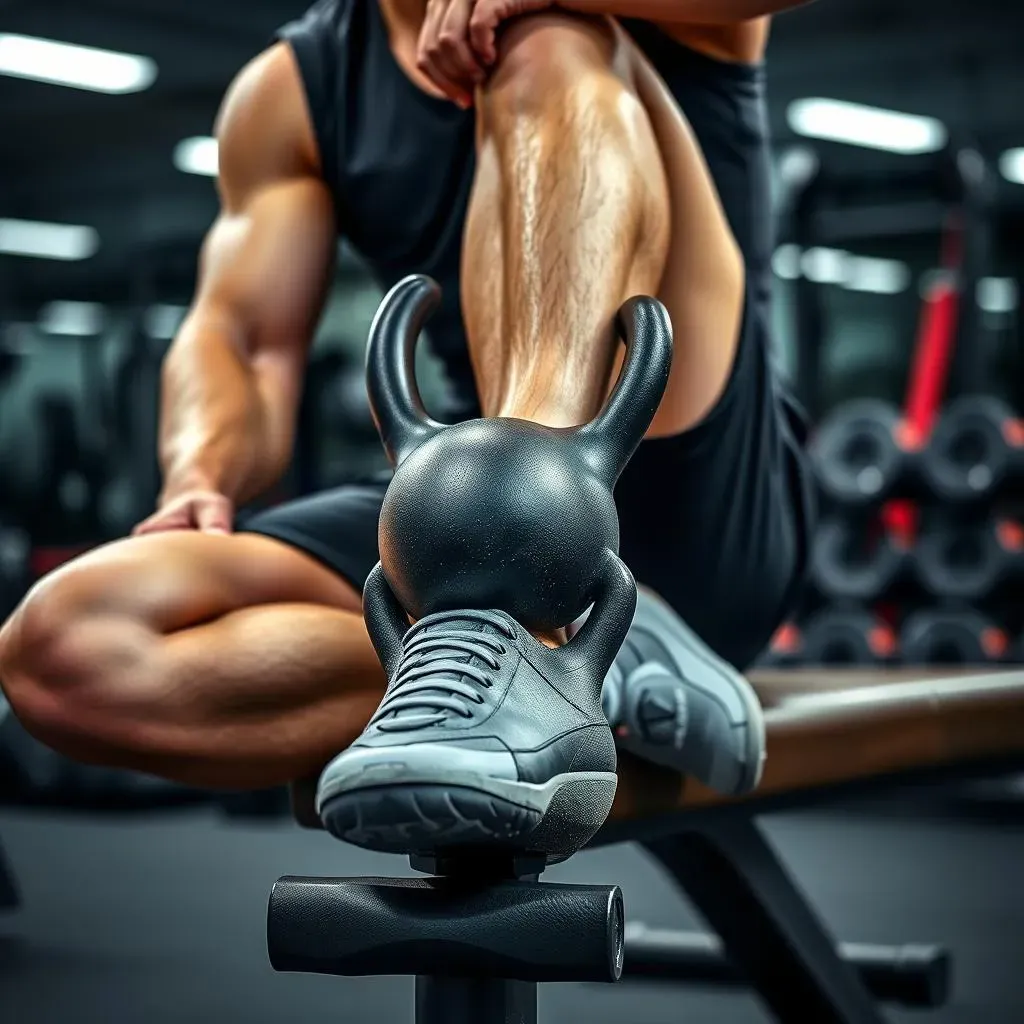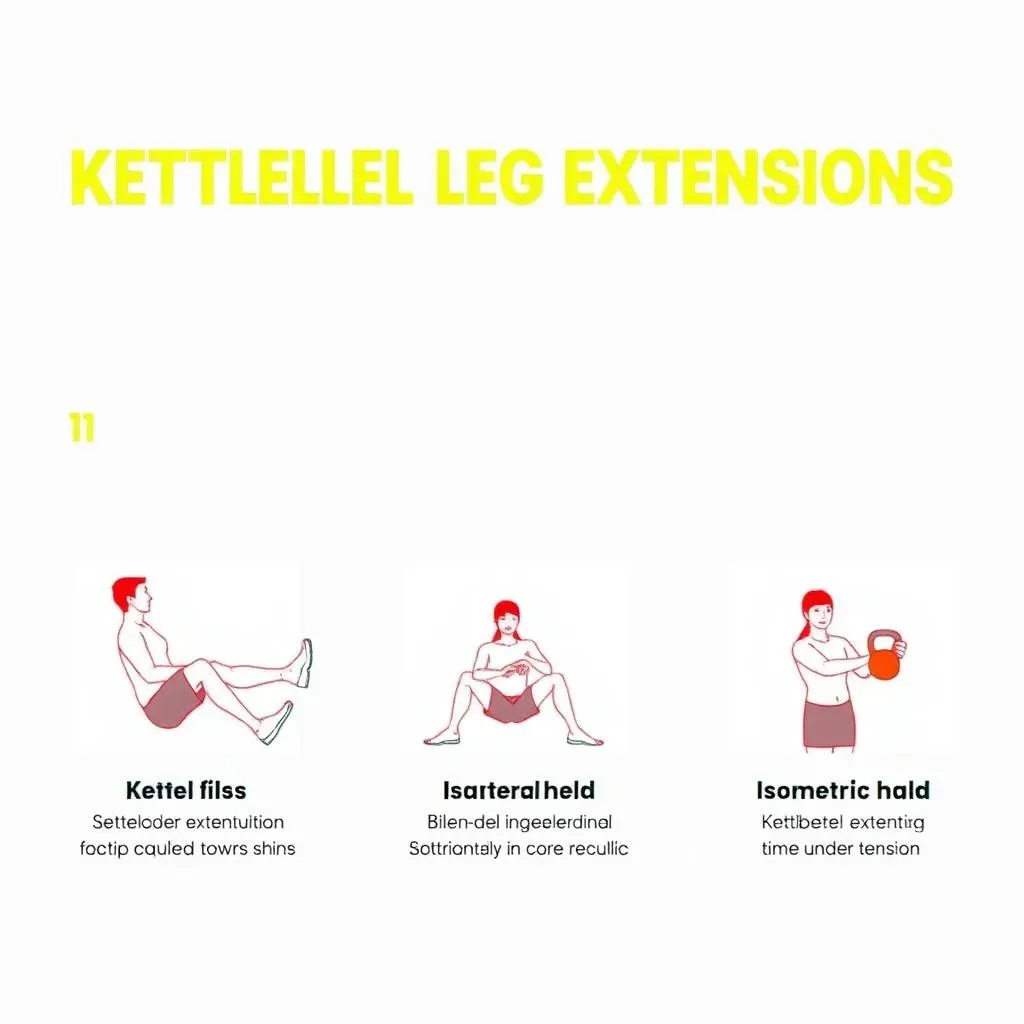Table of Contents
Want to build stronger, more defined quads without hitting the gym? The kettlebell leg extension is your answer. This often-overlooked exercise is a powerhouse for isolating and strengthening your quadriceps, and it can be easily incorporated into your home workouts. Forget those bulky machines – all you need is a kettlebell and a little bit of space to start seeing results.
Mastering the Kettlebell Leg Extension: A StepbyStep Guide

Mastering the Kettlebell Leg Extension: A StepbyStep Guide
Setting Up for Success
Alright, let's get into the nitty-gritty of performing a proper kettlebell leg extension. First things first, you'll need a kettlebell. Start with a weight that challenges you but doesn't compromise your form. A good starting point for beginners is usually between 5-10 kgs (10-22 lbs), and you can adjust as you get stronger. Find a sturdy chair or bench – something that allows you to sit comfortably with your feet dangling freely. Make sure it's not too high, or you won't get the full range of motion.
Now, sit on the chair with good posture. Hold the kettlebell by the horns (the sides of the handle) or the bell itself, depending on what feels most secure. Position the kettlebell just above your ankles, resting it on your shins. Your core should be engaged, and your back straight. Think about maintaining a slight arch in your lower back to prevent rounding. This setup is crucial for isolating the quads and avoiding any unnecessary strain on your knees or back.
Executing the Extension
Once you're set, it's time to perform the extension. Slowly extend your legs forward, lifting the kettlebell until your legs are almost parallel to the floor. Focus on squeezing your quads at the top of the movement. It’s a mind-muscle connection thing, really feel those muscles working! The key here is control. Avoid just flinging the weight up; that defeats the purpose and increases your risk of injury.
Pause briefly at the top, holding the contraction for a second or two. Then, slowly lower the kettlebell back to the starting position, maintaining control throughout the entire range of motion. Repeat for the desired number of reps. Aim for 3 sets of 10-15 reps to start, and adjust as needed based on your fitness level and goals. Remember to breathe – inhale as you lower the weight and exhale as you extend your legs. Consistency is key, so try to incorporate this exercise into your routine 2-3 times per week for optimal results.
Step | Description |
|---|---|
1 | Securely position the kettlebell above your ankles. |
2 | Slowly extend legs, squeezing quads at the top. |
3 | Pause briefly, holding the contraction. |
4 | Lower weight with control. Repeat. |
Benefits of Kettlebell Leg Extensions: Why Add Them to Your Routine?

Benefits of Kettlebell Leg Extensions: Why Add Them to Your Routine?
so you've nailed the form, now let's talk about why you should even bother with kettlebell leg extensions. First off, **quad isolation** is a huge benefit. Unlike compound exercises that work multiple muscle groups at once, the kettlebell leg extension really hones in on your quads, allowing you to target them directly for maximum growth and definition. This is especially great if you have lagging quads or just want to give them some extra attention. Beyond aesthetics, stronger quads translate to improved athletic performance. Think about it: quads are essential for running, jumping, squatting, and just about any lower body movement you can think of. By strengthening them with kettlebell leg extensions, you'll see improvements in your overall power, speed, and agility. Plus, strong quads are crucial for knee stability, which can help prevent injuries and keep you active and pain-free for longer.
Variations of the Kettlebell Leg Extension: Finding the Right Fit for You

Variations of the Kettlebell Leg Extension: Finding the Right Fit for You
Seated Kettlebell Leg Extension with Active Dorsiflexion
Ready to spice things up? Let's talk variations! First up, we've got the seated kettlebell leg extension with active dorsiflexion. Now, what's dorsiflexion, you ask? It's just a fancy way of saying "pull your toes towards your shins." By actively dorsiflexing your foot during the extension, you're not only working your quads but also engaging your shin muscles (tibialis anterior). This helps create a more balanced lower leg and can improve ankle stability. To do it, simply focus on pulling your toes up towards your knees as you extend your leg with the kettlebell. You'll feel the burn in a whole new way!
Bilateral Kettlebell Leg Extension
Next, we have the option of performing the kettlebell leg extension with both legs simultaneously. While this variation requires a bit more coordination and core stability, it can be a great way to increase the intensity and challenge. Instead of using one kettlebell, you'll need two, one for each leg. The movement is the same – extend your legs forward, squeezing your quads at the top – but now you're doing it with both legs at the same time. This variation is great for those who have mastered the single-leg version and are looking for a new challenge.
Variation | Focus | Benefits |
|---|---|---|
Active Dorsiflexion | Shins and Quads | Improved ankle stability |
Bilateral Extension | Both legs simultaneously | Increased intensity and core engagement |
Isometric Hold Kettlebell Leg Extension
Finally, if you're looking to really crank up the intensity, try adding an isometric hold to the kettlebell leg extension. An isometric hold simply means holding the weight in a fixed position for a certain amount of time. In this case, you'll perform the extension as usual, but instead of immediately lowering the weight back down, you'll hold it at the top of the movement for a few seconds. This increases the time under tension, which can lead to greater muscle growth and strength gains. Start with holding for 2-3 seconds and gradually increase the duration as you get stronger. Trust me, your quads will be screaming!
Avoiding Mistakes and Staying Safe with Kettlebell Leg Extensions

Avoiding Mistakes and Staying Safe with Kettlebell Leg Extensions
Common Form Faux Pas
Alright, let's talk about some common pitfalls to watch out for when performing kettlebell leg extensions. One of the biggest mistakes people make is using too much weight too soon. Starting with a weight that's too heavy can lead to poor form, which not only reduces the effectiveness of the exercise but also increases your risk of injury. It's always better to start light and gradually increase the weight as you get stronger. Another common mistake is rushing the movement. Remember, control is key. Don't just fling the weight up and down; focus on a slow, controlled execution throughout the entire range of motion. This ensures that your quads are doing the work, not momentum.
Also, avoid locking out your knees at the top of the movement. Locking your knees puts unnecessary stress on the joint and can lead to pain or injury. Instead, keep a slight bend in your knees throughout the exercise. And finally, pay attention to your posture. Slouching or rounding your back can put strain on your spine. Sit up tall with your core engaged to maintain proper alignment.
Protecting Your Knees and Back
Kettlebell leg extensions can be a great exercise, but they can also put stress on your knees and back if not performed correctly. To protect your knees, make sure you're not locking them out at the top of the movement and that you're using a weight that you can control. If you have pre-existing knee issues, you may want to consult with a physical therapist before adding this exercise to your routine. To protect your back, focus on maintaining good posture throughout the exercise. Sit up tall with your core engaged, and avoid rounding your back. If you find yourself slouching, it may be a sign that the weight is too heavy or that you need to take a break.
Also, consider using a chair with good back support to help maintain proper alignment. And remember, it's always better to err on the side of caution. If you're unsure about your form or if you're experiencing any pain, don't hesitate to seek guidance from a qualified fitness professional. They can help you assess your technique and make any necessary adjustments to ensure that you're performing the exercise safely and effectively.
Safety Tip | Description |
|---|---|
Start Light | Begin with a manageable weight to master form. |
Controlled Movement | Avoid rushing; focus on slow, deliberate reps. |
Proper Posture | Sit tall with core engaged to protect your back. |
Listen to Your Body | Stop if you feel pain and reassess. |
Conclusion: Kettlebell Leg Extensions for the Win
So, there you have it: a comprehensive guide to the kettlebell leg extension. It's a simple yet effective exercise that can significantly contribute to your lower body strength and muscle definition. Whether you're a seasoned athlete or just starting your fitness journey, incorporating kettlebell leg extensions into your routine can bring noticeable improvements. Remember to prioritize proper form, listen to your body, and gradually increase the weight as you get stronger. With consistent effort and the right technique, you'll be well on your way to achieving those strong, sculpted quads you've always wanted. Now grab that kettlebell and get to work!